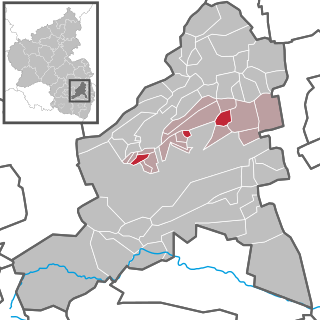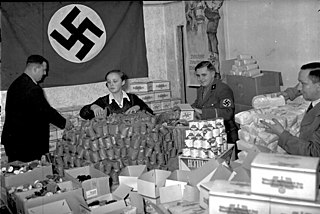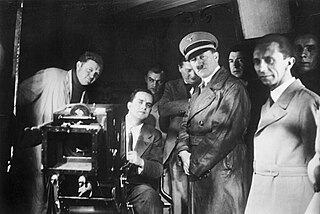
The Nazi Party, officially the National Socialist German Workers' Party, was a far-right political party in Germany active between 1920 and 1945, that created and supported the ideology of Nazism. Its precursor, the German Workers' Party, existed from 1919 to 1920. The Nazi Party emerged from the German nationalist, racist and populist Freikorps paramilitary culture, which fought against the communist uprisings in post-World War I Germany. The party was created to draw workers away from communism and into völkisch nationalism. Initially, Nazi political strategy focused on anti-big business, anti-bourgeois, and anti-capitalist rhetoric. This was later downplayed to gain the support of business leaders, and in the 1930s the party's main focus shifted to antisemitic and anti-Marxist themes.

The swastika symbol, 卐 or 卍, is an ancient religious icon in various Eurasian cultures. It is used as a symbol of divinity and spirituality in Indian religions, including Hinduism, Buddhism and Jainism.

John Heartfield was a German visual artist who pioneered the use of art as a political weapon. Some of his most famous photomontages were anti-Nazi and anti-fascist statements. Heartfield also created book jackets for book authors, such as Upton Sinclair, as well as stage sets for contemporary playwrights, such as Bertolt Brecht and Erwin Piscator.

The Rise and Fall of the Third Reich: A History of Nazi Germany is a book by the journalist William L. Shirer, in which the author chronicles the rise and fall of Nazi Germany from the birth of Adolf Hitler in 1889 to the end of World War II in Europe in 1945. It was first published in 1960, by Simon & Schuster in the United States. It was a bestseller in both the United States and Europe, and a critical success outside Germany; in Germany, criticism of the book stimulated sales. The book was feted by journalists, as reflected by its receipt of the National Book Award for non-fiction, but the reception from academic historians was mixed.

The flag of Nazi Germany, officially the flag of the German Reich, featured a red background with a Swastika on a white disc. This flag came into use initially as the banner of the Nazi Party (NSDAP) after its foundation. Following the appointment of Adolf Hitler as Chancellor in 1933, this flag was adopted as one of the nation's dual national flags, the other being the black-white-red horizontal tricolor of the German Empire.

The War Order of the German Cross, normally abbreviated to the German Cross or Deutsches Kreuz, was instituted by Adolf Hitler on 28 September 1941. It was awarded in two divisions: in gold for repeated acts of bravery or military leadership; and in silver for distinguished non-combat war service. The German Cross in Gold ranked higher than the Iron Cross First Class but below the Knight's Cross of the Iron Cross, while the German Cross in Silver ranked higher than the War Merit Cross First Class with Swords but below the Knight's Cross of the War Merit Cross with Swords.

The 20th-century German Nazi Party made extensive use of graphic symbols, especially the swastika, notably in the form of the swastika flag, which became the co-national flag of Nazi Germany in 1933, and the sole national flag in 1935. A very similar flag had represented the Party beginning in 1920.

The National Socialist Workers' Party of Denmark was the largest Nazi Party in Denmark before and during the Second World War.

Werner Naumann was State Secretary in Joseph Goebbels' Ministry of Public Enlightenment and Propaganda during the Nazi Germany era. He was appointed head of the Propaganda Ministry by Führer Adolf Hitler in his last will and testament after Goebbels was promoted to Reichskanzler. Naumann was present in the Führerbunker in late April 1945.

The term Reichskriegsflagge refers to several war flags and war ensigns used by the German armed forces in history. A total of eight different designs were used in 1848–49 and between 1867–1871 and 1945.
Hitler and the Occult, produced by Bram Roos and Phyllis Cannon, and narrated by actor David Ackroyd, is a 50-minute History Channel documentary regarding Nazi occultism.

The Ministry of Aviation was a government department during the period of Nazi Germany (1933–45). It is also the original name of the Detlev-Rohwedder-Haus building on the Wilhelmstrasse in central Berlin, Germany, which today houses the German Finance Ministry.
The National Socialist German Students' Union was founded in 1926 as a division of the Nazi Party with the mission of integrating University-level education and academic life within the framework of the Nazi worldview. Organized strictly in accord with the Führerprinzip as well as the principle of Machtdistanz, the NSDStB housed its members in so-called Kameradschaftshäusern, and had its members decked out in classic brown shirts and its own distinctive Swastika emblems.

Herxheim am Berg is an Ortsgemeinde – a municipality belonging to a Verbandsgemeinde, a kind of collective municipality – in the Bad Dürkheim district in Rhineland-Palatinate, Germany.

The celebration of Christmas in Nazi Germany was allowed, though it included attempts by the regime to bring the Christian religious holiday into line with Nazi ideology. The Jewish origins of Jesus and the commemoration of his birth as the Jewish Messiah was troubling for some members of the Nazi group and their racial beliefs. Between 1933 and 1945, some government officials attempted to remove these aspects of Christmas from civil celebrations and concentrate on cultural pre-Christian aspects of the festival. However, church and private celebrations remained Christian in nature.
Hans Severus Ziegler was a German publicist, theater manager, teacher and Nazi Party official. A leading cultural director under the Nazis, he was closely associated with the censorship and cultural co-ordination of the Third Reich.

The Deutsche Zeichentrickfilme GmbH (DZF) was founded on 25 June 1941 by Reich propaganda minister Joseph Goebbels and was clearly seen as an important war facility. It was set up as an alternative to Disney, attempting to rival films such as Mickey Mouse, while spreading the Nazi ideology and propaganda through a less aggressive entertainment source.
Das dumme Gänslein(The Silly Goose) is one in a trio of German animated short films produced in 1944 by Hans Fischerkoesen, who was the chief animator and author. It is a tale of a female goose consumed by adventure and urban glamour in her countryside life, who has to be saved from a cunning fox by her friends and family. The overt moral of the cartoon is to avoid an extravagant and adventurous life due to its possible unexpected consequences, but rather to lead a ‘normal’ (German) family life. Though this "There's no place like home" theme was a commonplace of 1930's and '40s animation, in this cartoon there is special emphasis, typical of Nazi propaganda, on the Völkisch ideology of conformity and conventionality, portraying individualism and sexual freedom as inherently both alien and dangerous. The cartoon suggests that divergence from traditional German life could be dire, even possibly lethal, in line with National Socialist characterizations of opponents of the regime as asocial, disloyal, and self-destructive. The film also hints at anti-Semitism through the character of the cunning fox.















